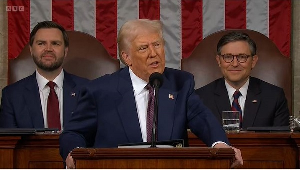Kojo Appiah-Kubi (PHD)
Published in Business Week
On the assumption of power in 2009 the new NDC government set for itself the pursuit of a social democratic agenda to promote „A Better Ghana? with real opportunities for gainful employment, prosperous enterprise and social and economic welfare for all our people as its main goal. This article attempts to assess the performance of the government after almost a year in government against the backdrop of the goals it set for itself on assumption of office at the beginning of the year.
Fiscal Performance: The NDC government met on assumption of office a high budget deficit of about 11.25 per cent of GDP (including divestiture receipts) at the beginning of 2009 and some huge arrears and commitments carried over from 2008, of which it managed to clear about GH¢227.3 mil-lion by September 2009. As at the end of September 2009, the budget deficit was estimated to be equi¬valent to 6.4 per cent of GDP and is expected to rise to about 10.2 per cent of GDP by the end of 2009 as against the projected deficit of about 9.4 per cent of GDP in 2009. An important dimension of the deficit is its financing, the source of which can pose a serious fiscal constraint on the subsequent budgets. It can also lead to increases in the country’s indebtedness and interest payments. The budget deficit of 2009, for instance, was financed from domestic (3.8 per cent of GDP) and foreign sources (2.6 per cent of GDP). The net domestic financing is projected to be about 26.3 per cent higher than the 2009 budget estimate. The extent of this fiscal constraint on the budget was also evident during the year, as the country’s public debt rose by US$458.7 million to US$8,517.7 million and interest payments on domestic debt by 62.76 per cent at the end of September 2009.
It must also be pointed out that revenue performance was less than satisfactory. Overall receipts for the year were almost 14 per cent below target and 9.22 per cent below the provisional 2008 outturn. Indeed with the exception direct taxes almost all other tax revenues fell short of projected budget estimate. Exchange Rate: The beginning of the year witnessed wide volatility in the exchange market. Between January-October 2009 the cedi depreciated by about 18, 29 and 23 per cent against the US dollar, the pound and the euro respectively. This compares with depreciations of 18 and 6 per cent against the US dollar and the euro respectively and an appreciation of 3 per cent against the pound over the corresponding period in 2008. The wide volatility in the first half of the year eased during the third quarter of the year with the restoration of confidence in the performance of the economy and positive expectation on the market. Indeed the sharp decline in imports by 23.4 per cent appears to have contributed immensely to the easing of tensions on the exchange rate as well as on the balance of payments accounts. As a result the country’s balance of payments improved significantly from a record deficit of US$716.8 million in 2008 to US$29.5 million in 2009, whilst gross international reserves rose from an import cover of 2.1 months in 2008 to about 2.4 months in 2009.
Inflation: At the beginning of 2009 the government projected an average and end period inflation target of 15.3 and 12.5 per cent respectively as against the inflation rate of 18.1 per cent it inherited from the previous government. Even though the government has made some progress in reversing the inflationary trend from the peak of 20.7 per cent in June 2009 to 18.04 per cent at the end of October, the projections for the year are likely to be missed out due to internal and external challenges that confront the fight against inflation. It is, however, gratifying to note that food inflation has since its peak level of 19.3 per cent in April 2009 consistently fallen to 13.5 per cent by end October, 2009, largely due to favourable weather conditions.
Interest rates: The need to bring down inflation necessitated the Bank of Ghana in the course of the year to embark upon a tight monetary policy through open market operations and the prime rate hikes from 17 per cent in December 2008 to 18.5 per cent in February 2009 and this caused lending base interest rates to remain relatively high at above 25 per cent through out the year. This high interest rate has run counter to government attempts to reduce cost of borrowing to boost economic activity.
Public Debt: According to the NDC government gross public debt (comprising public external debt, US$4,644.2, and domestic debt, GH¢5,308.2) rose by about US$458.7 million to US$8,517.7 million at the end of September 2009, largely as a result of an increase in external debt. This raised the debt burden from 48 per cent of GDP at the beginning of the year under review to 59.7 per cent of GDP as at end September 2009 and close to the limit of 60 per cent set in the budget as the long-term target.
Growth Record: The new government does not seem to have started with a good growth record. The real GDP growth of 4.7% recorded during the year is about 2.6 percentage points lower than the previous growth record of 7.3 per cent attained in 2008. Even though the record is significantly higher than the expected average growth of 1.1 per cent in most sub-Sahara African countries, it nonetheless falls far short of the government’s own budgetary target of 5.9 per cent and that of the GPRS II of about 7 per cent. It is also far lower than the government’s medium term target of 8-10% deemed adequate for the desired transformation of the economy into a middle income status. The sharp drop can be attributed to the contractionary government demand policy as reflected in the substantial decline of government expenditure of about 5.4 per cent and 23.4 per cent in nominal and real sense respectively by an assumed annual average inflation rate of 18 per cent. To the government the contractionary policy was necessary on account of the need to ensure macroeconomic stability intended to prepare the grounds for a sustainable accelerated growth.
The available sectoral growth estimates in 2008 indicate that the agricultural sector continues to dominate the economy. Provisional estimates reveal that growth in the agricultural sector peaked at 6.2 per cent during the year under review, and was largely driven by accelerated growth rate of 6.5 per cent in crops and livestock sub-sector, as a result of good weather pattern coupled with increases in area under cultivation and improved yields. Growth in the industrial sector tumbled to an all time low since 2000 to finish off at 3.8 per cent, far below the achieve growth rate 8.1 per cent in 2008 and the annual growth target of 5.9 per cent for 2009. The government attributes the lower than expected performance of the sector, largely, to the substantial output contraction by one per cent against a 12 per cent positive growth rate achieved in 2008 and a growth target of 8 per cent in the construction sub-sector. The highest growth rate of 9 per cent for the year 2009 was recorded in the industrial sector by the electricity and water sub-sector, but that was still lower than the 19.4 per cent registered in the previous year. The second highest growth was witnessed in the mining and quarry sub-sector, which grew by about 8 per cent in 2009, as a result of substantial increases in gold demand, which pushed up prices to unprecedented high levels. This growth rate, however, exceeded its annual projection of 5.5 per cent and that of 2008 of 2.1 per cent. Growth in the manufacturing sub-sector rose to reach a new high of 5 per cent and above the achieved growth rate of 4.5 per cent for the previous year and the annual projected growth rate of 4 per cent for the year under review.
The upward growth trend in the services sector in the last two decades was halted in 2009 as it posted its lowest growth rate of 4.6 per cent for the year under review as against 9.3 per cent in 2008 and an annual target of 6.6 per cent. This was due largely to the poor performance of the wholesale and retail trade sub-sector, whose growth rate fell from 10.2 per cent in 2008 to 2 per cent in 2009.
Implications for Well-being: In the past consistent growth of the GDP had translated into higher real per capita GDP growth rates and consequently into accelerated reduction in poverty levels. This contributed to successively raise the per capita GDP (income) growth rate from below 2 per cent in 2000 to about 4.8 per cent or from about US$220 in 2000 to about US$712 in 2008. The result is a substantial drop in the incidence of poverty from 39.5 per cent in 1999 to about 26.5 per cent in 2008. The slowdown in economic activity, particularly, in the industrial sector, which is supposed to generate the needed employment for the teeming youth and its consequent effect on the growth of the GDP as well as the rapid depreciation of the cedi are thus likely to affect negatively poverty reduction.
The above review of the economic developments reveals mixed performance of the economy during 2009 under the NDC government. Apart from the slight improvement on the fiscal front the country witnessed deterioration in many macroeconomic conditions. Not only did the government fail to improve upon the 2008 economic performance, it also failed to achieve most of its targets set for 2009. This indeed brings into dispute the appropriateness of the economic policies and strategies of the NDC government to deal with the problems of the country and the efficacy of the chosen tools of economic management of this government.
Opinions of Tuesday, 5 January 2010
Columnist: Appiah-Kubi, Kojo


















